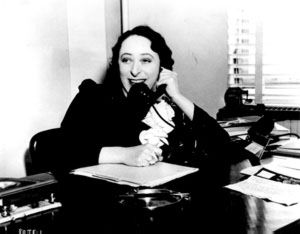
Painted Dreams
Encyclopedia

Soap opera
A soap opera, sometimes called "soap" for short, is an ongoing, episodic work of dramatic fiction presented in serial format on radio or as television programming. The name soap opera stems from the original dramatic serials broadcast on radio that had soap manufacturers, such as Procter & Gamble,...
that was the first daytime radio soap opera program in the United States. It premiered October 20, 1930 and last aired in July, 1943.
In 1930 radio station WGN
WGN (AM)
WGN is a radio station in Chicago, Illinois, USA. It is the only radio station owned by the Tribune Company, which also owns the flagship television station WGN-TV, the Chicago Tribune newspaper and Chicago magazine locally. WGN's transmitter is located in Elk Grove Village, Illinois...
asked Irna Phillips
Irna Phillips
Irna Phillips was an American actress and most notably writer who created and scripted many of the first American soap operas.Phillips created radio and TV soap operas including:...
, who worked for them as an actress, to create a 15-minute daily show "about a family," to air during the day. Painted Dreams was the result.
Phillips wrote and acted in the show until 1932 when she asked WGN to sell the show to a national broadcaster. When they refused, Phillips sued, claiming the show was her property. The dispute was finally settled in 1938, and the show was acquired by CBS
CBS
CBS Broadcasting Inc. is a major US commercial broadcasting television network, which started as a radio network. The name is derived from the initials of the network's former name, Columbia Broadcasting System. The network is sometimes referred to as the "Eye Network" in reference to the shape of...
. Meanwhile, Phillips had left WGN in 1932, creating Today's Children
Today's Children
Today's Children was a name shared by two thematically related American radio soap operas created and written by Irna Phillips, the earliest of which was her first nationally networked series.-1933-1938 series:...
for rival station WMAQ with virtually the same plot premises and characters.
Plot
Phillips' storyline followed the relationship of Irish-American widow Mother Moynihan and her unmarried daughter. Listeners in 1931 heard this dialogue in episode 25:- (Kitchen: Irene and Sue arguing. Mrs. Moynihan preparing breakfast.)
- IRENE: I tell you, Sue, it won’t work. I’ve never worn that shade of orchid in all my life. I’d look like a perfect washout. Besides, that’s your very best special occasion dress. I wouldn’t think of taking it.
- SUE: Don’t be silly. A wedding is a special occasion, isn’t it? And as long as I won’t need to wear it, you might just as well. If you’re a bridesmaid, you’ve got to look the part, kid.
- IRENE: But I don’t look good in that color. I’d look faded or something.
- SUE: Cracked ice! You can’t tell. You’ve never had it on. Gee, with gold slippers and a gold turban hat, you’d be a wow! Wouldn’t she, Mrs. Moynihan?
- MRS.: Won't you be wearing it, Sue?
- SUE: Why no; there's no reasons for my dressing up. I'm not in the wedding party. And I think that it would be just right for Irene, if there were a few tucks taken in around the waist. Anyway, it would save her from buying a dress.
- IRENE: Well, who says I don't want to buy a dress? It's about time I was getting a new formal, anyhow. I haven't got a rag that's fit to be seen.
Phillips occasionally played the lead of Mother Moynihan, as did Bess Flynn, who was a member of the show's writing team. Flynn, born August 18, 1899 in Tama. Iowa, went on to script for three other soap operas: We, the Abbotts, Bachelor's Children
Bachelor's Children
Bachelor's Children was a domestic daytime drama broadcast which originated on Chicago's WGN in 1935-36, continuing on CBS and NBC until 1946....
and Martha Webster (originally titled Life Begins). In addition to doing the title role on Martha Webster, she also portrayed the annoying maid Tilda on The Gumps
The Gumps
The Gumps, a popular comic strip about a middle-class family, was created by Sidney Smith in 1917, launching a 42-year run in newspapers from February 12, 1917 until October 17, 1959....
.

